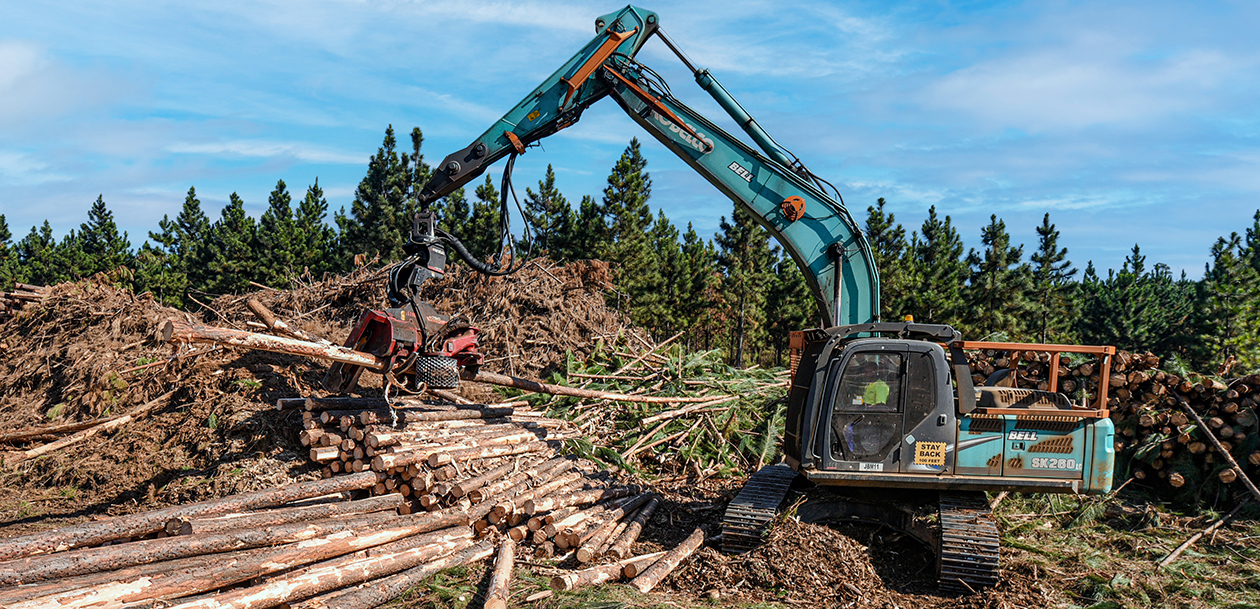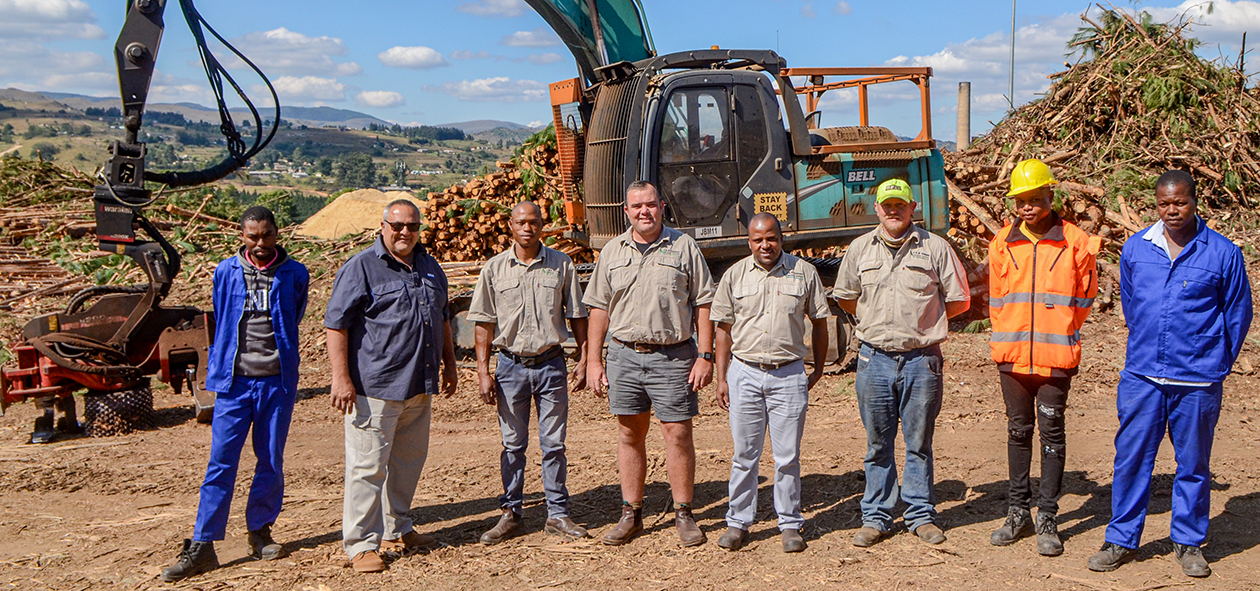Kobelco and Bell are a winning combination for J & B Timbers
Published: 28 September 2022

Barend Steenkamp faced a somewhat unique problem in his felling, extraction and loading of pine thinnings operation in forests in the west of Eswatini. His contract called for full tree-lengths, up to fifteen metres long, to be loaded onto specialised stinger-steer truck-trailer combinations, but there was not enough space in the narrow roads between forest compartments to do this safely.
Barend is the fifth generation of farmers in South Africa’s landlocked neighbouring country. His family first farmed dairy but, starting small, moved into timber harvesting in 2010. While still farming with livestock, this new arm of the business, J & B Timbers, has grown exponentially since then.
“Our client, a large timber grower and sawmilling group, had amended our current contract to now process full tree lengths on a deck near the mill,” Barend explains. “Their thinking was that they wanted to harness the biomass that is traditionally left in the compartment after felling, extraction and cross-cutting, in one place which is near the mill. In that way, they could also possibly utilise this biomass, in which they now saw value, as fuel for power generation. Removing the biomass from the compartment would also reduce the fuel load that forest fires thrived on.”
“Added to this was the thought that the recovery of saw-wood, the most valued commodity, would be increased through easier handling on the deck close to the mill.”
This meant that instead of cross-cutting the felled tree at roadside, the full tree-length would now be transported to a specialised open area or deck as it’s called, near to the mill, where the full tree-lengths would be processed by removing the branches which form the biomass and doing the cross-cutting there.
“We were using a Kobelco SK210LC-10 Excavator carrier fitted with a MT600 grapple to load timber but, because of the narrow road, we could not turn the Excavator at ninety degrees to the truck to load the full tree-lengths safely,” Barend continues. “This is when I took a design idea to Justin Bell, Product Designer of Bell Equipment’s Forestry and Agriculture division to see if we could fit a hydraulic heel to an extension on the MTR600 grab to steady the bunched timber and so create a steady fulcrum to do this safely while loading full tree-lengths.
“The almost similar knuckle-boom concept has been widely used in the forestry industry in both the USA and New Zealand,” says Justin Bell. “This means that we didn’t have to reinvent the wheel so to speak but rather make adjustments to what was at hand and create a live heel which is different from the stationary heel on a knuckle-boom loader.”
According to Justin, one such major consideration was to lengthen the dipper on the excavator with a nose cone to accommodate the standard bucket cylinder of the Kobelco SK210LC-10 Excavator whilst still achieving the required heel range of motion, making aftermarket support of the complete product easier.
“Both static and dynamic (live) heels are in use globally, and whilst it would have been quicker and simpler to bolt or weld a static heel onto the dipper of the Kobelco SK210LC-10 Excavator, the live heel certainly provides a wider range of operating configurations for the tight space constraints Barend had to deal with.”
Justin commends Maxwell Quarmby, one of Bell Equipment’s young design engineers who in consultation with himself, who produced both the design and drawings for this innovative project and despite the challenges, took it in his stride.
“We now have a pretty smooth flowing felling, extraction and loading operation of pine thinnings in the forest thanks to these applied innovative ideas,” Barend continues. “This came about as a result of higher tonnages as stipulated by harvesting contracts, and as always, we make every effort to comply and do it safely, as this is our livelihood.”
J & B Timbers uses a Bell MT50FH Single-stem Feller-Buncher head fitted to a Kobelco SK135SR Excavator to fell trees as the flexible boom quickly reaches into areas where a traditional felling machine can’t always go. Again, this Feller-buncher head came about as an idea that Barend had brought forward after using the Fastfell and this particular model is the first one that the Forestry and Agriculture division of Bell Equipment had produced.
The same machine then places the felled trees in piles in the compartment from where a Bell Skogger extracts them to the road where the Kobelco SK210LC-10 Excavator, fitted with the live heel attachment, loads the full tree-lengths onto the stinger-steer trailers.
The average fuel burn on the Kobelco SK210LC-10 Excavator comes in at 10,8 litres an hour and that of the Kobelco SK135SR at 9,8 litres an hour of which both figures fit comfortably into the business plan.
On the processing deck, J & B Timbers deploys three Kobelco SK260LC-10 Excavators fitted with third party processing heads to strip the branches and bark and cross-cut the timber into predetermined lengths. Currently, the three Kobelco machines produce 18 000 tons of timber a month and run an average of 18 hours in a 24-hour cycle.
“These Kobelco SK260LC-10 machines are phenomenal and seem to idle along while producing more than enough hydraulic flows to efficiently drive the processing heads at sustained mechanical availabilities,” Barend says. “And their added benefit is that they do all this running on average at 8% cheaper than competitor machines in the same mass class.”
“Kobelco have got this right by creating a simple machine with far less electronics,” he adds. “Let it be said though that none of this sustained performance would be possible without the non-stop great service that we get from Charlie Boucher and his entire team at Bell Equipment in Matsapha.”
Barend makes special mention of Bruce Larkan, Bell Equipment’s Product Support Representative who happens to live near to J & B Timbers’ operation and stops off every second day on his way home to check the condition of the various machines or to drop off service kits or essential consumables.
When asked about the company’s replacement based on machine hours Barend says: “Our policy would stipulate 20 000 hours, which is high but which we’re confident of getting due to good design and build of especially the equipment we buy from Bell Equipment, and due to diligent and preventative maintenance which we see to ourselves, with Bell Equipment’s support. Our next machine purchase will be another Kobelco SK260LC-10 Excavator fitted with a third party processing head to replace an older machine that has given us 14 000 hours of great service. The older machine will get its original bucket back and we’ll take it to the farm where it will do maintenance earthworks.”
Barend is adamant that machines from Bell Equipment provide the backbone of his timber harvesting, extraction and processing operations and this is evident in the number of such branded machines the company owns. The fleet includes no less than eight Bell Loggers, a Fastfell and three Skoggers, one Kobelco SK135SR, three SK210LC-10s and now four SK260LC-10 Excavators with a variety of heads.

Mandla Nkosi Dlamini, Charlie Boucher (Customer Service Centre Manager: Bell Equipment Swaziland), Salpelo Dlamini, Barend Steenkamp (MD: J & B Timbers), Brian Sibandze, Edmund Bothma, Mcolisi Sibanyoni and Victor Kunene.
